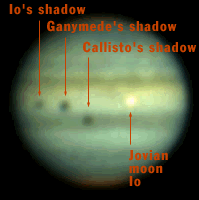

The four major, or "Galilean," satellites of Jupiter form a miniature Solar System, where "years" are measured in days. The motions of these worlds have interested astronomers since Galileo and are still of interest for two reasons: (1) improving the "models" of their orbits, particularly for planning space missions; and (2) investigating the effects of tides on the movements of Io and Europa. (In order outward from Jupiter, the Galileans are Io, Europa, Ganymede, and Callisto.) In order to do this, we need accurately to measure the positions of these moons; from Earth the best means are by timing when these bodies enter or leave the shadow of Jupiter.
A satellite eclipse begins with the satellite's ingress disappearance
and ends with its egress reappearance. Seen from the Northern Hemisphere
of Earth, in an inverting telescope, the satellite would be moving from
left to right when near eclipse. Before opposition, an eclipse event (if
visible at all) appears to the left of the disk; after opposition, to the
right. However, an eclipse ingress or egress may be invisible because
Jupiter gets in the way.
|
|
Date |
Contact |
Contact |
|
|
|
|
|
|
|
|
|
|
|
|
|
|
|
|
|
|
|
|
|
|
|
|
|
|
|
|
|
|
|
|
|
|
|
|
|
|
|
|
|
|
|
|
|
|
|
|
|
|
|
|
|
|
|
|
|
|
|
|
|
|
|
|
|
|
|
|
|
|
|
|
|
|
|
|
|
|
|
|
|
|
|
|
|
|
|
|
|
|
|
|
|
|
|
|
|
|
|
|
|
|
|
|
|
|
|
|
|
|
|
|
|
|
|
|
|
|
|
|
|
|
|
|
|
|
|
|
|
|
|
|
|
|
|
|
|
|
|
|
|
|
|
|
|
|
|
|
|
|
|
|
|
|
|
|
|
|
|
|
You can download a really cool program that will give you the locations of Jupiters 4 large moons right on your computer: